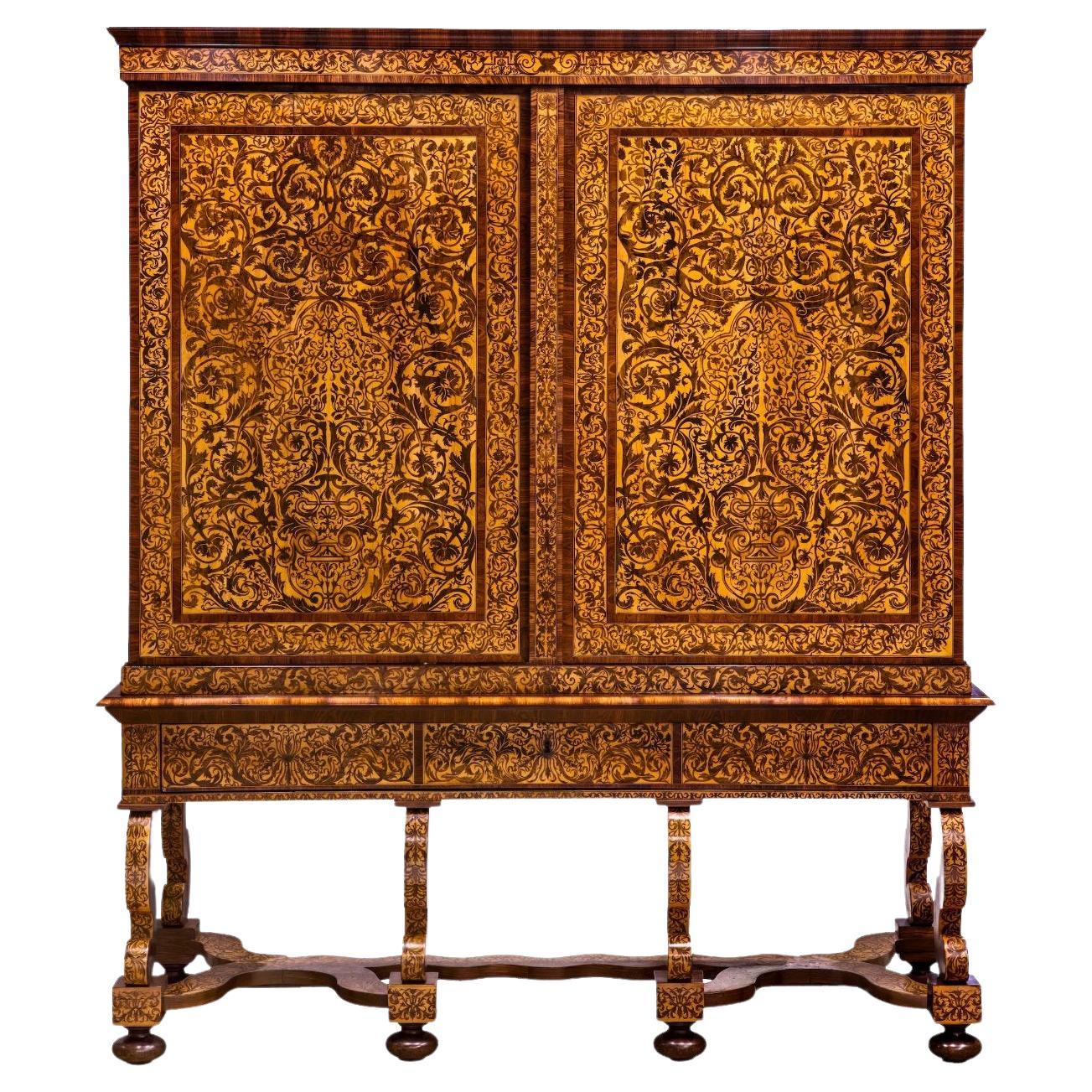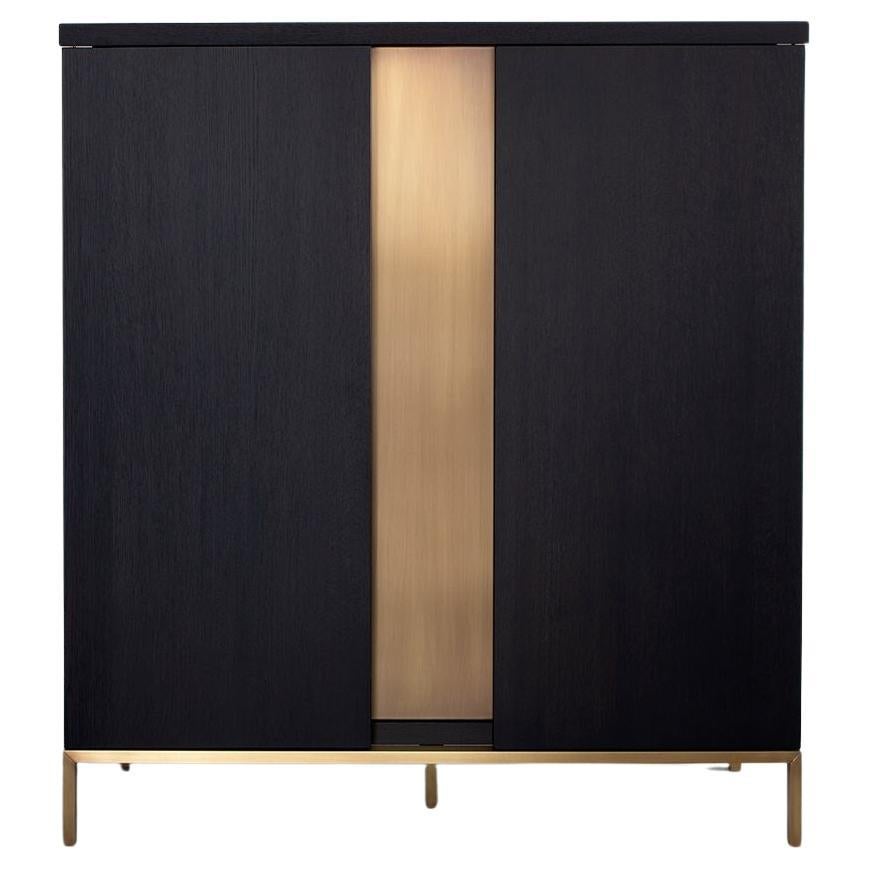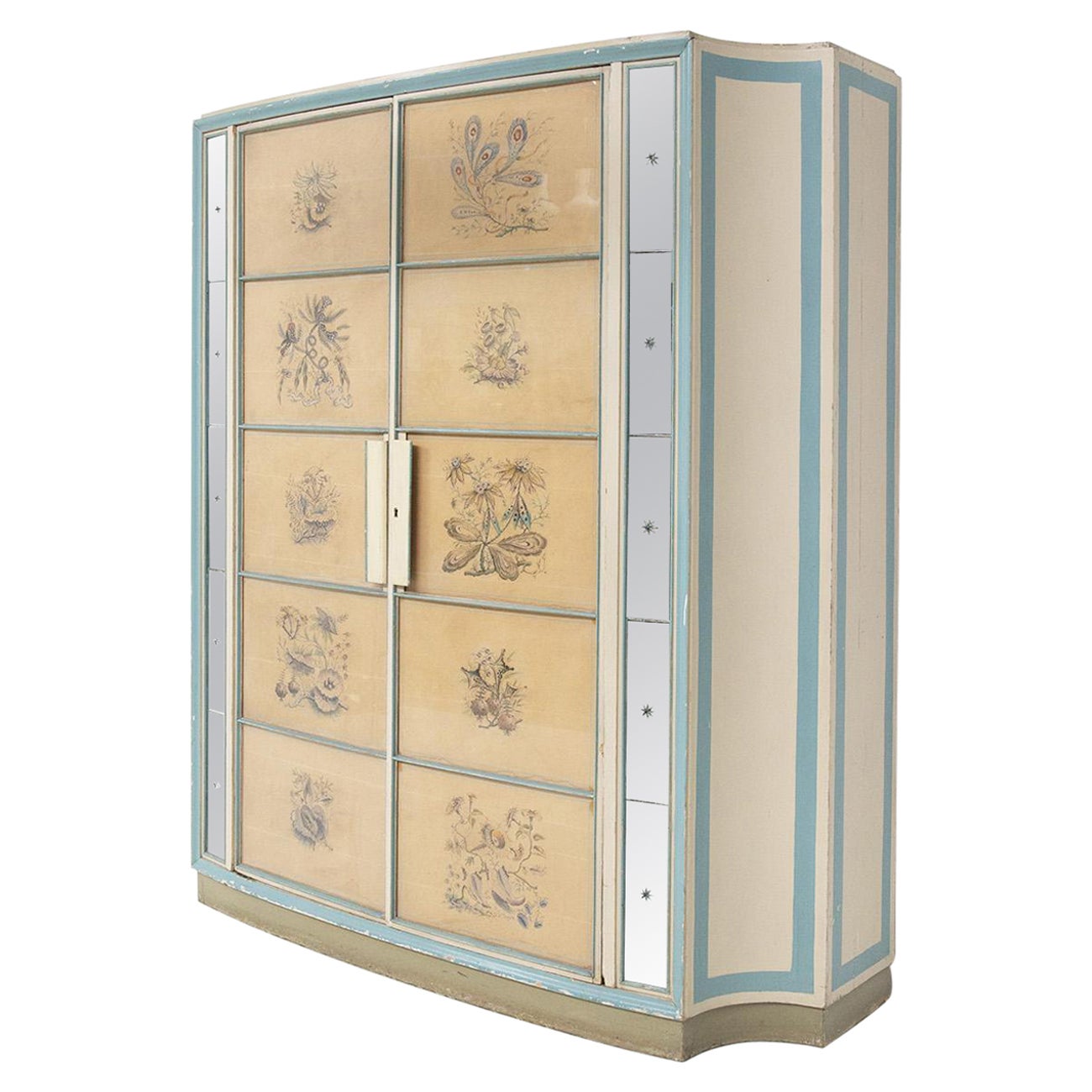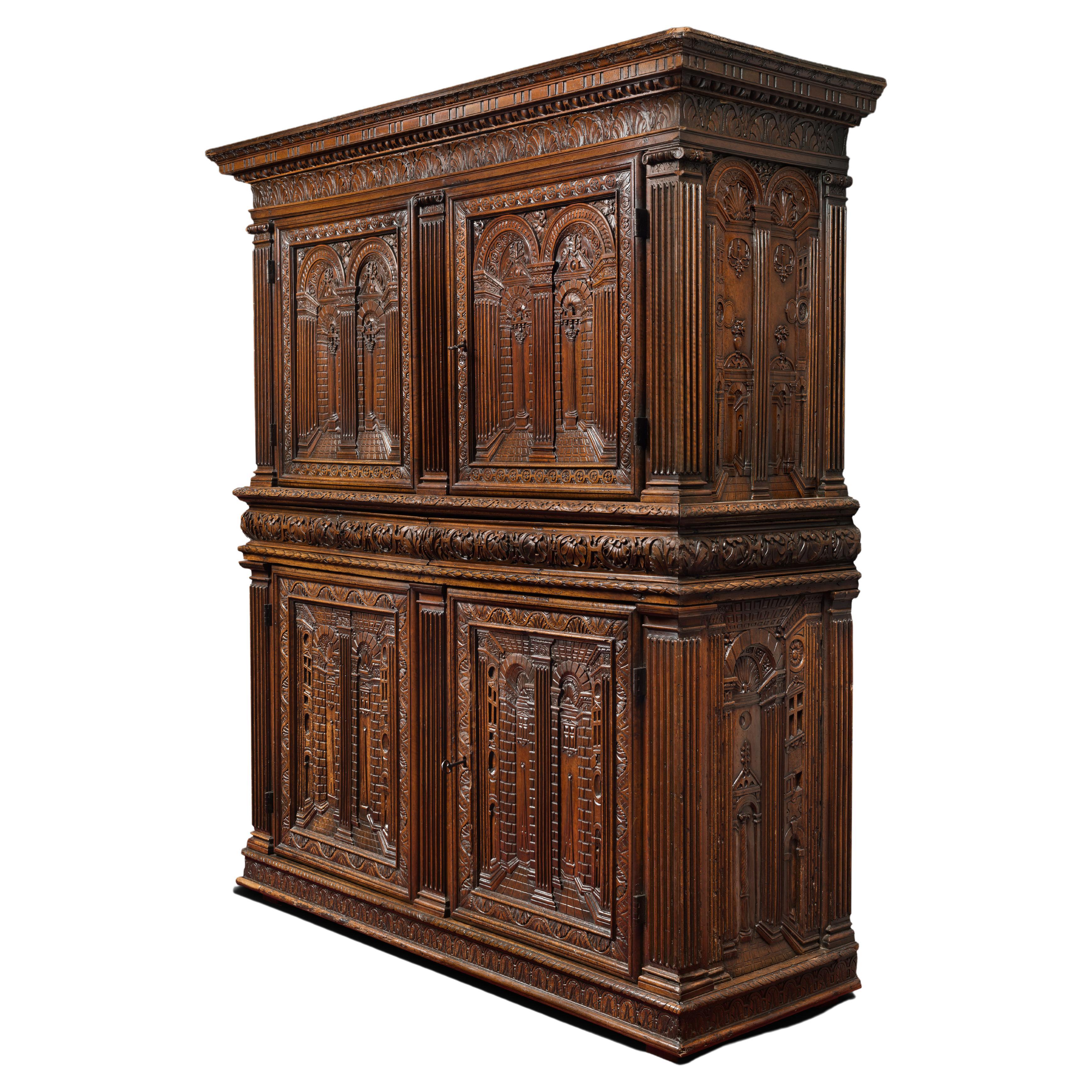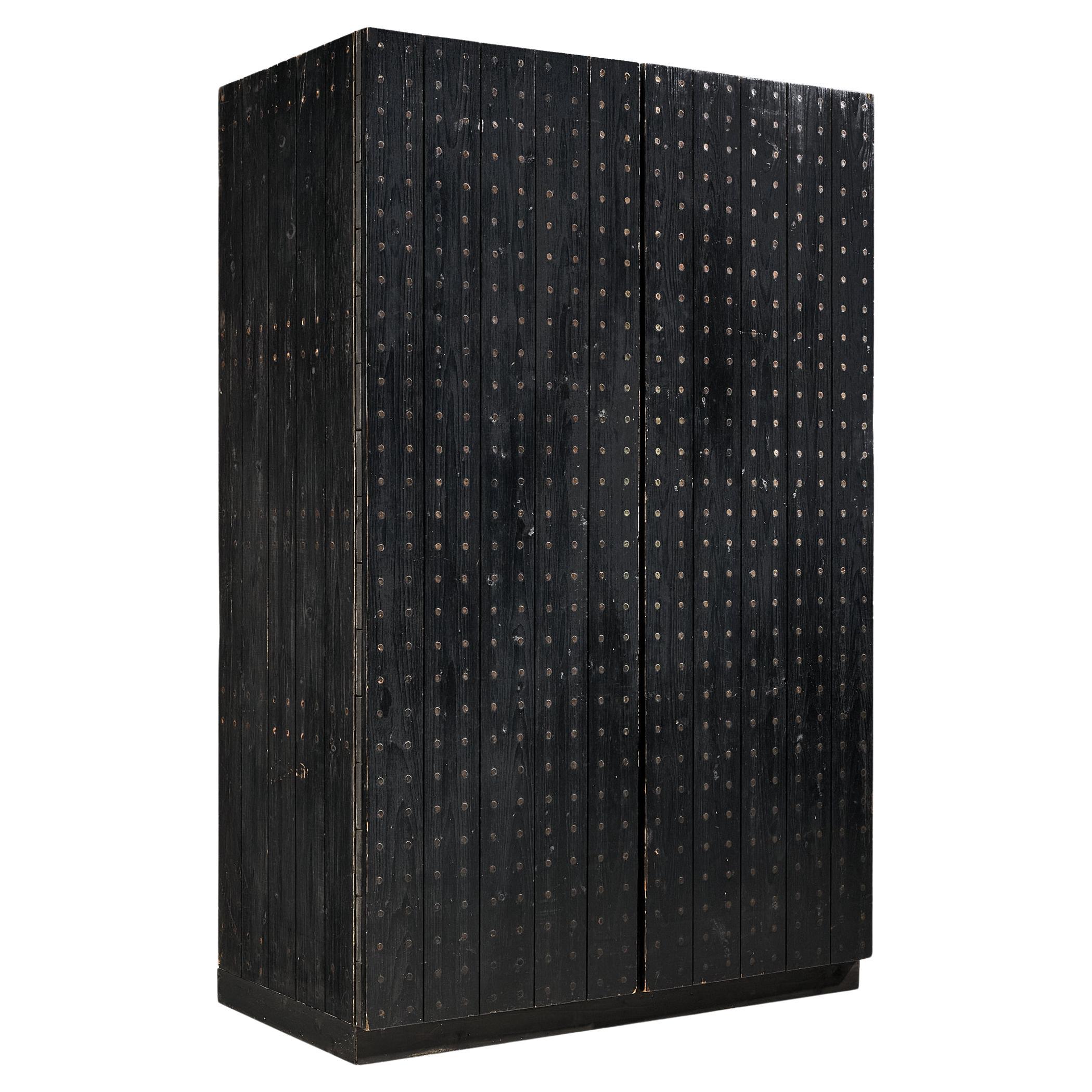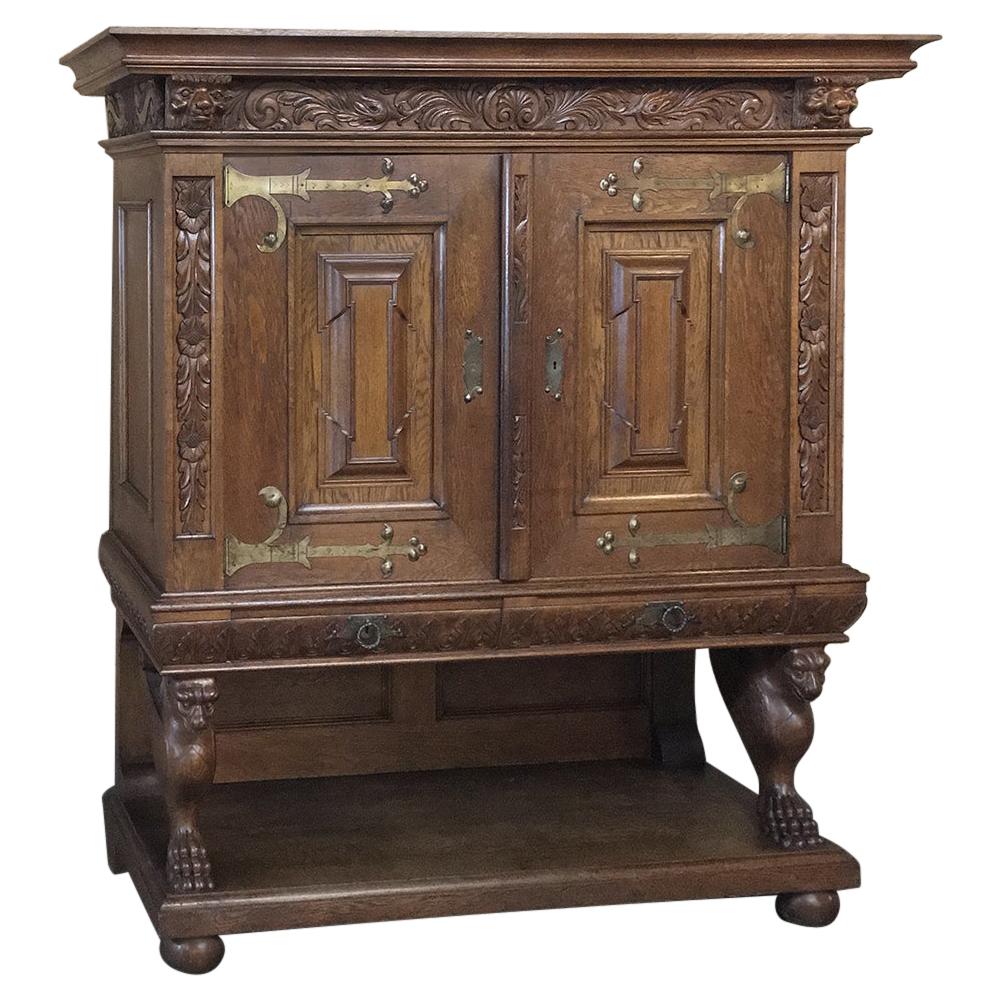Items Similar to Highly Important Dutch Floral Marquetry Cabinet by Jan van Mekeren, circa 1700
Want more images or videos?
Request additional images or videos from the seller
1 of 18
Highly Important Dutch Floral Marquetry Cabinet by Jan van Mekeren, circa 1700
About the Item
The Van Mekeren cabinet:
A Newly Discovered Pinnacle by the Master of Marquetry
The highly important Dutch marquetry Van Mekeren cabinet
Amsterdam, circa 1700, by Jan van Mekeren (1658-1733)
Measures: H. 206 x W. 171 x D. 61 cm
The cabinet and all its oak bases have been retained in their original state. The whole cabinet is covered with floral marquetry veneer of various woods, including walnut, holly, laburnum, boxwood, satine´ rubane´, amaranth, tulipwood, barberry, elm, sycamore, olive wood, padouk and kingwood. A modest rectangular cornice over a frieze inlaid with marquetry of various flowers over two doors with marquetry depicting urns on a plinth issuing bouquets of tulips, bluebells, cornflowers, marigolds, irises, peonies, daffodils, crown imperials, roses, lilies, anemones, chrysanthemums and carnations; several different species of butterflies and moths, including Arctia caja, swallowtails, garden white, meadow brown, and a brimstone butterfly, at least three different bird species, including turtle dove, thrush, and warbler, and a garden snail, Cepaea hortencis. The sides each centred by an oval also with garlanded urns issuing bouquets of flowers. The doors opening to a plain interior with two shelves, two drawers and three base drawers, all multiple wood veneered. The original, partly hollow oak bases of the doors have been filled, in the 1970s, with a board material for stabilisation. The reverse of the doors is inlaid with a rosewood star. Below the doors, a conforming border and a large drawer are also inlaid with small flower bunches. The legs, joint by waved Y-shapes stretchers, each consistently inlaid with flowers.
Provenance:
The present and V&A cabinet were both possibly ordered by Jens Wijbergen, a Dutch merchant living in Copenhagen. According to the Van Mekeren archives an order was placed by Wijbergen in 1700, probably for two cabinets, because the price was comparable to other orders for a pair of Van Mekeren cabinets. The previous owner of the present cabinet, living in Austria, is a descendant of a patrician family from Riga. Some members of the Danish Wijbergen family are known to have moved to Riga in the early 18th century.
Jan van Mekeren, born in Tiel 1658, moved to Amsterdam in 1687 where he was recorded as ‘kabinetmaker’ or ‘kistenmaker,’ and where he married Maria Hovinck, 26 years old. Before moving to Amsterdam, Jan van Mekeren had been in London in 1682 where he had asked to be admitted to the Dutch Reformed Church. He apparently wanted to stay for some time in London presumably to learn the art of furniture marquetry. In 1687 he is mentioned as guildsman, member of the St. Josef guild in Amsterdam. Apparently, he was quite successful as a cabinetmaker because in 1693 he bought a house in the expensive Kalverstraat and extended his business into the wood trade as well. Since the head-quarter of the VOC was in Amsterdam the city was the foremost European market for exotic woods in the 17th century.
Jan and Maria had six children. Jan intended his first son Fikko, born in 1693, to succeed him as cab-inet maker but unfortunately Fikko died in 1731. After Jan’s death in 1733 the wood trade was con-tinued by his daughter-in-law but there was no one able to continue his cabinet making business. Despite a 1624 regulation stipulating that members of the Amsterdam cabinetmaker’s guild who offered their wares for sale in the guild’s shop, furniture makers in the 17th and 18th century Holland hardly ever marked their work. However, thanks to the inventory after Jan’s death, there is a good list of his workpieces with thorough descriptions, prices, and the names of his clientele.
The estate included many finished and unfinished pieces of furniture, a large collection of cabinet woods, and, most interesting, a long list of claims with names of the debtors and the amounts due. Most debtors were well known Amsterdam patricians, only a few were from outside Amsterdam, including Jens Wijbergen from Copenhagen, who still owed Jan van Mekeren fl. 33,13.
?
Because of a very close resemblance, this cabinet possibly is the pendant of the Van Mekeren cabinet now in the Victoria & Albert Museum (W.5:1 to 14-1986). There are minor differences in the flower decorations on the doors and sides of the cabinet, but a pair of Van Mekeren cabinets in castle Amerongen ordered as a pair, look less like each other than the present cabinet and its possible pendant in the V&A.
During the second half of the 17th century flower paintings became popular and among the most famous flower painters were two women: Maria van Oosterwijk (1630-1693) and Rachel Ruysch (1664-1750). Jan van Mekeren’s flower bouquets issuing from urns on a plinth bear close resemblance to the bouquets painted by these two women artists.
Only six other van Mekeren cabinets are known: one in the Rijksmuseum Amsterdam (inv. R.B.K. 1964-12), one in the Metropolitan Museum New York (1995, 371a, b), one in the Victoria and Albert Museum, one in Charlecote Park, Warwickshire, and a pair in Amerongen Castle, the Netherlands.
- Creator:Jan van Mekeren (Cabinetmaker)
- Dimensions:Height: 81.11 in (206 cm)Width: 67.33 in (171 cm)Depth: 24.02 in (61 cm)
- Materials and Techniques:
- Place of Origin:
- Period:Late 17th Century
- Date of Manufacture:circa 1700
- Condition:Replacements made: Overall in excellent condition for a marquetry cabinet from the 17th century, especially since all other cabinets known are in bad condition. For a full restoration and condition report, send us a message. Repaired: Overall in excellent condition for a marquetry cabinet from the 17th century, especially since all other cabinets known are in bad condition. For a full restoration and condition report, send us a message. Refinished. Wear consistent with age and use. Overall in excellent condition for a marquetry cabinet from the 17th century, especially since all other cabinets known are in bad condition. For a full restoration and condition report, send us a message.
- Seller Location:Amsterdam, NL
- Reference Number:1stDibs: LU5458229625622
About the Seller
5.0
Vetted Seller
These experienced sellers undergo a comprehensive evaluation by our team of in-house experts.
Established in 1985
1stDibs seller since 2020
19 sales on 1stDibs
Typical response time: 3 hours
- ShippingRetrieving quote...Ships From: Amsterdam, Netherlands
- Return PolicyA return for this item may be initiated within 7 days of delivery.
More From This SellerView All
- A magnificent Dutch marquetry cabinet on stand, by Jan van Mekeren (1658-1733)By Jan van MekerenLocated in Amsterdam, NLA magnificent Dutch marquetry cabinet on stand, by Jan van Mekeren (1658-1733) possibly made for William III and Mary of England Amst...Category
Antique 17th Century Dutch Antiquities
MaterialsKingwood, Oak, Walnut, Holly
- 17th Century Dutch-Colonial Indonesian Sono Keeling Foliate Cabinet on StandLocated in Amsterdam, NLAn Indonesian Sono keeling or Javanese rosewood foliate cabinet on stand or Rankenkast Jakarta (Batavia), late 17th century Measures: H 173 x W 133 x D 51 cm The front of this cabinet is decorated with three carved swags of fruits and flowers coming out of cherub’s heads, a long drawer under two doors and two shelves behind the doors. Usually, this type cabinet...Category
Antique Late 17th Century Sri Lankan Dutch Colonial Cabinets
MaterialsRosewood
- Islamic Indonesian Djati Wood Display Cabinet, circa 1917Located in Amsterdam, NLAn Indonesian Djati display cabinet Chinese furniture-makers working in Batavia, late 18th century, dated 1799 Measures: H. 201.5 x W. 120 x D. 53.5 cm In the middle of the ...Category
Early 20th Century Indonesian Dutch Colonial Cabinets
MaterialsTeak
- Rare Dutch Maternity or Child's Cabinet, in Dutch 'Luiermandskast', circa 1650By Herman DoomerLocated in Amsterdam, NLA rare Dutch Renaissance 17th-century Maternity room or Child's cabinet, in Dutch called 'Luiermandskast' circa 1650, possibly the circle of Herman Doomer...Category
Antique Mid-17th Century Dutch Renaissance Cabinets
MaterialsEbony, Oak
- Magificent Dutch 'Daniel Marot' Baroque Walnut Burr Cabinet on Stand, circa 1720By Daniel MarotLocated in Amsterdam, NLThe Marot cabinet A Magnificent Walnut Burr Cabinet on stand or 'kruisvoetkabinet' in the style of Daniel Marot Circa 1720, probably made for George Clifford III in Amsterdam or the Hague The cabinet is one of the rarest examples of a so-called Kruisvoetkabinet, which is translated to Cabinet on stand. The cabinet is raised on a stand with eight legs and tree drawers. Below the drawers and on the sides are five carved ornaments. The hollow formed corners are mounted with carved ornaments too. The upper part of the cabinet has two doors decorated with panels and on each door two carved ornaments in Marot style. The cabinet has a double dome top.The interior of the cabinet has tree shelves and five drawers. The brass fittings and handles are original and finished with gilt lacquer. The cabinet is made of oak and veneered with burr walnut. The carvings, turned parts and the ball feet are made of solid walnut. This cabinet is a unique piece of Dutch furniture. Cabinets on stand became popular in the third quarter of the 17th century and were made until the second quarter of the 18th century. Most of the dutch cabinets on stand...Category
Antique Early 18th Century Dutch Louis XIV Cabinets
MaterialsOak, Walnut
- William & Mary Seaweed Marquetry Inlaid Cabinet by Gerrit Jensen (c. 1634-1715)By Gerrit JensenLocated in Amsterdam, NLAn Anglo-Dutch William and Mary Seaweed Marquetry cabinet on stand by Gerrit Jensen, Royal Cabinetmaker England, circa 1690 The cabinet is c...Category
Antique Late 17th Century British William and Mary Cabinets
MaterialsBrass
You May Also Like
- Nota Bene Cabinet by Van RossumLocated in Geneve, CHNota Bene cabinet by Van Rossum Dimensions: D120 x W50 x H136 cm Materials: Oak, brass. The wood is available in all standard Van Rossum colors, or in a...Category
2010s Dutch Post-Modern Cabinets
MaterialsBrass
- Important cabinet by Paolo Buffa production Arrighi in glass and woodBy Paolo Buffa, Giovanni Gariboldi, Serafino ArrighiLocated in Milano, ITImportant closet cabinet by Paolo Buffa for Arrighi's 1950s Italian production. The wardrobe is a great product of rare beauty , it is a priceless piece...Category
Vintage 1950s Italian Mid-Century Modern Cabinets
MaterialsBrass
- Important Renaissance Cabinet from Lyon 'France' with a Decor of PerspectivesLocated in Saint-Ouen, FRAs soon as 1540 France's second Renaissance is in the making, intimately linked to the rediscovery of the Antique world. The development of the printing and engraving industry allows the spread of artworks and models in many cities and countries. The Italian influence can be perceived in every artistic field. While the French king entrust the most talented Italian artists with major projects such as Il Rosso or Primaticcio in Fontainebleau, French artists also travel to Italy to form themselves to this new style. In Italy they get acquainted with the work of Leo Battista Alberti the first to theorize perspective (De Pictura, 1435-36) and architecture (De re oedificatoria, 1541). Those two publications would have a revolutionary impact on arts. Furniture is marked by the work of the most famous Italian architects of the time as well as French architects. Indeed Philibert de l'Orme competes with Alberti and by the end of his life publishes several treaties including one devoted to a theory of architecture (1567). Unfortunately he would not live to complete the second volume. In this treaty he expresses his interest for mathematical norms applied to architecture, copied from the Antique. His journeys in Italy allowed him to accumulate the most sophisticated references. Jean Bullant, another architect of great talent also theorizes his practice. He establishes rules characterizing Greco-Roman art staying faithful to Vitruvius. Following this new inspiration the structure of furniture evolves. From then on appear columns, capitals, cornices, friezes and architraves. The ornamentation uses this inspiration as well with egg-and-dart, palm leaf and rose adorning the most beautiful pieces. In Lyon, crossroad where meet merchants from everywhere those new experiments are welcomed. Lyon florishing printing industry allows the spreading of models and treaties essential to the artist's work. Thus the first publication of Vitruvius' De Architectura in France would be printed in Lyon in 1532. Artists from Lyon rediscover and familiarize themselves with the Antique knowledge very early. They adopt those new ideas and use them in their own creations. Lyon cabinet-makers re interpret Antique architecture and Italian Renaissance palaces to give their pieces a pure and harmonious architectural structure. Grooved pilasters are particularly favored. They are topped by capitals of diverse orders always respecting the sequencing with simpler ones for the lower levels and the richest ones on the higher levels. As for the ornamentation, one of the great distinctiveness of Lyon workshops remains the architectural perspective illusions, drawing inspiration from Tuscany. True masterpiece of the Second French Renaissance this important cabinet illustrates Lyon workshops' taste for fine Italian architecture inspired by Antiquity. An architectural perspective of great quality is treated in symmetry on each panel. This two-bodied cabinet without recess stands on four rectangular feet. The base comprises a molding, a palm leaf frieze and is bordered by a braid. The lower body is divided by three grooved pilasters with Tuscan capitals framing two door-leaves. The two panels are encircled by a moudled frame with palm leaves. They are finely carved with a decor of fantasized architecture depicting an Italian Renaissance palace erected symmetrically on each side of a grooved pilaster. On the ground floor a door opens through a stilted arch while the stories are opened with mullioned windows, dormers and occuli. Two large pegged-boss cladded pillars support the entablature enriched by a palm leaf frieze upon which stands an arch whose coffered intrados is centred by a rose. Behind this arch a pyramid appears, standing in front of a second facade with a window topped by a broken curvilinear pediment under a cul-de-four with a shell. The checker flooring gives depth to the low-reliefs creating vanishing points structuring the panels and guiding the eye of the observer. A thin laurel braid highlights the belt of the cabinet where are located two drawers. Their facades are adorned by palm leaves in hoops. The upper body is encircled with palm leaves. The same ternary division as in the lower body appears. However, the pilasters are topped by Ionic capitals with volutes and egg-and-dart. The door-leaves are framed with flowers. On the panels the artist has designed another architectural decor. On the foreground open two arches on top of grooved pilasters with rectangular capitals adorned with palm leaves. The arches are enriched with braids and the coffered intrados bears a decor of roses. The spandrels also bear a flower decor. In the background another arcature hosts a fluted grooved column topped with double basket acanthus capital, characteristic of Corinthian order. The triangular pediment is interrupted by a choux bourguignon. A large cornice crowns the cabinet. It stands on pilasters and forms an entablature comprising a palm leaf frieze and an egg-and-dart, triglyph and palm leaf cornice. The cabinet's sides have also been carefully considered. The lower body's panels are enriched with an arch rising above a broken pediment portico hosting a twisted column. Flowers garnish the spandrels. An architectural facade completes the decor. The upper body's panels present two arches supported by a facade opened with dormers and mullioned windows as well as cartouches (one bears the inscription 1580 dating the cabinet) suggesting the interior of an Italian Renaissance palace, confirmed by the chandeliers. The flooring leads our gaze to a second arch with a broken curvilinear pediment where stands a flower vase. This arch opens onto a perspective of another facade along a road. Inside the cabinet, on the lower body door-leaves appear two designs. On the right door is depicted a Crucifixion. Saint Mary and Saint John flank the Christ on the cross. In the bottom part is inscribed « Dure uiator abis nihil haec spectacula curas / Pendenti cum sis unica cura Deo. / Tota suo moriente dolet natura Magistro. / Nil qui solus eras caussa dolenda doles. ». The signature [Christoff Swartz Monachiensis pinx[it] / Ioa[nnes] Sadeler sculp[it]] tells us it was made by Johan Sadeler I (1550-1600) after Christoph Schwartz (1548-1592). This engraving belongs to an ensemble depicting the Passion of Christ Johan Sadeler executed in 1589 after an altar piece painted by Christoph Schwartz for the private chapel of Renée of Loraine, wife of Duke William V of Bavaria. This altar piece made of nine copper panels has been destroyed during the 19th century. The Crucifixion panel once in the centre of the altar piece is the only one that survived and is today kept in Munich's Alte Pinakothek. On the left door appears Saint Francis receiving the stigmata. The inscription says : « Signastidomine Servum Tuum. Franciscum. Signis Redemptionis Nostrae ». This Renaissance cabinet with an architectural decor appearing as much in the structure faithful to Antique rules...Category
Antique 16th Century European Renaissance Cabinets
MaterialsWalnut
- Dutch Bossche School Cabinet in Black Stained PineLocated in Waalwijk, NLDutch cabinet, pine, metal, The Netherlands, 1970s This striking cabinet originates from The Netherlands. Its cubic appearance is emphasized by the dark colored wood. Vertically arr...Category
Vintage 1970s Dutch Brutalist Cabinets
MaterialsMetal
- 19th Century Dutch Hand Carved Renaissance Raised CabinetLocated in Dallas, TX19th century Dutch hand carved Renaissance raised cabinet was rendered from dense, old-growth quarter sawn oak, examples of which are on displa...Category
Antique Mid-19th Century Dutch Renaissance Revival Wardrobes and Armoires
MaterialsSteel
- Antique German Hand Painted Cabinet, circa 1850Located in Amsterdam, Noord HollandA beautiful cabinet from the rural south of Germany, dating from circa 1850. The cabinet was probably given as a wedding present. This cabinet is made ...Category
Antique 1850s German Rustic Wardrobes and Armoires
MaterialsPine
Recently Viewed
View AllMore Ways To Browse
Highly Important
Shop Antique Furniture
Old Time Pieces
Business Case
Cabinets Sale
Antique Looking Storage Cabinet
Important Estate
Long Side Cabinet
Old Master Pieces
City Cabinet
Floral Wood Cabinet
Butterflies Case
Butterfly Case
Extending Cabinet
Marquetry Floral
Cabinets On Sale
Pair Cabinet White
Estate Cabinet
